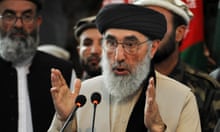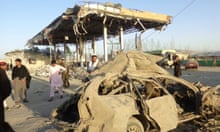Taliban suicide bombers have killed at least 43 Afghan soldiers by ramming two stolen Humvees strapped with explosives into an army base, using a tactic increasingly feared by government forces.
The attack on Wednesday night on an outpost in Kandahar’s Maiwand district left only two soldiers of a 60-strong unit unharmed, according to the defence ministry spokesman Dawlat Waziri. Nine soldiers were injured and six are still missing, he said.
Marking the deadliest week in the country since the announcement of Donald Trump’s new strategy to turn the Afghan war around, the attack adds to an unusually high death toll for Afghan government forces. Nearly 800 soldiers and police officers were killed in September.
On Tuesday, a wave of Taliban suicide attacks killed at least 74 people. In the worst attack of the day, in Paktia, 21 police officers and 20 civilians were killed, and more than 150 people wounded.
Stolen government fighting vehicles laden with bombs, as opposed to the widely used motorcycles or Toyota Corollas, a weapon long dreaded by soldiers and police, are increasingly used by the militants. Up-armoured Humvees have also been a favoured device of Islamic State fighters in places such as Mosul.
Three weeks ago, 35 Afghan security personnel were killed in a similar attack, also in Kandahar, which since last year, after a long period of relative calm, has experienced a rise in violence.
Humvees in the hands of Taliban fighters confuse soldiers and pack a large payload. They also provide propaganda tools. In Helmand, where they have carried out 13 such attacks, according to security officials, the Taliban have filmed drone footage of fighters speeding the vehicles packed with explosives into government bases.
In July the Taliban even claimed that the son of its supreme leader, Mawlawi Haibatullah Akhunzada, had driven one of the Humvees – claims that have never been verified.
While territory gained by the Taliban as they advance across the country is not always strategically important, attacks allow the rebels to capture valuable equipment.
If the government records the number of lost Humvees, it keeps the figures under wraps. However, a former governor last year told the New York Times that the Taliban had taken about 40 heavy-duty vehicles when they briefly captured Kunduz.
It is, however, not just Afghan equipment that finds its way into Taliban hands. In videos, Taliban fighters have also brandished what they claim are US-supplied machine guns, weapons optics and grenade launchers. Some of it is presumably war spoils, but Afghan government forces are also suspected of selling weapons and ammunition to the insurgents.
In the long, grinding war, with apparently no shortage of battle-keen insurgents, advantages on the battlefield often come down to equipment.
For government forces, a longstanding problem has been a deficiency of airpower, both to fight insurgents and evacuate its wounded.
US plans to replace the ageing Afghan fleet of Russian-made Mi-17 helicopters with 159 Black Hawks over the coming years will supposedly give Afghans a decisive advantage on the battlefield.
It could also make it easier for Afghans to destroy equipment stolen by the Taliban, something US rules of engagement, which only allow American war planes to conduct counter-terrorism missions and protect Nato forces under direct attack, often do not permit.
Earlier in the week, the UN security council condemned the “heinous and cowardly terrorist attacks” in Paktia and Ghazni.
Calling on the Taliban to respect civilian lives, the Afghanistan Independent Human Rights Commission called the attacks “a clear violation of human rights and it can be exemplified as war crimes”.








